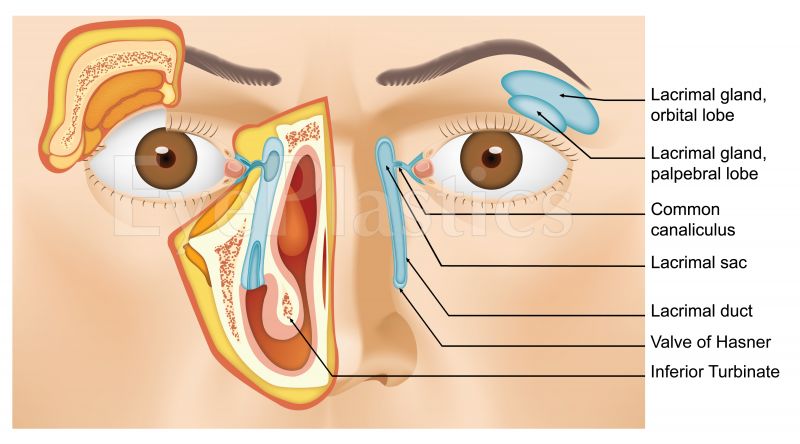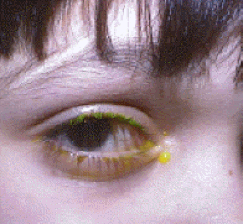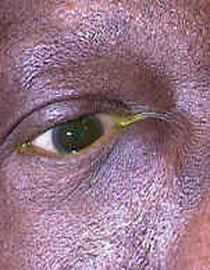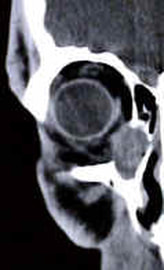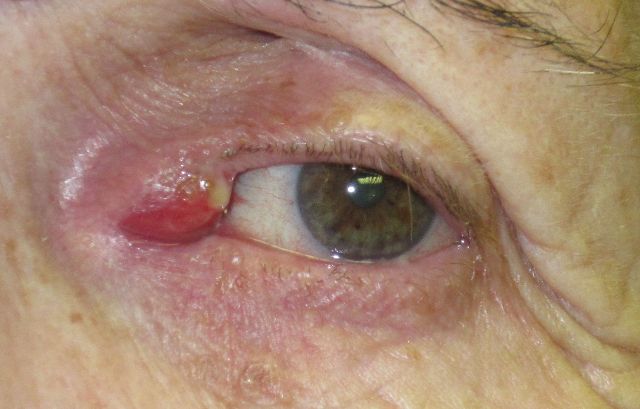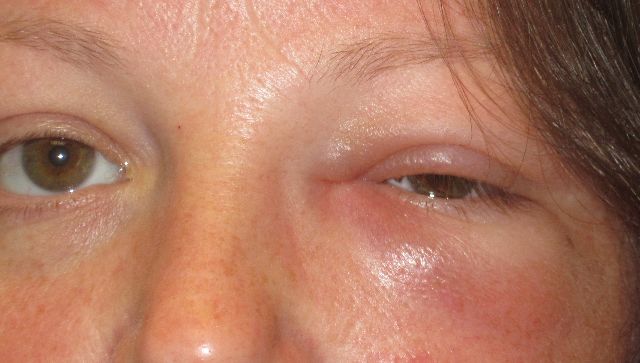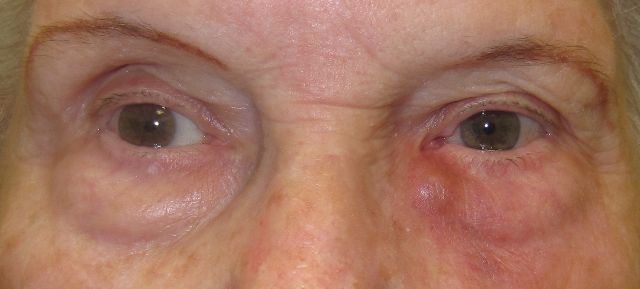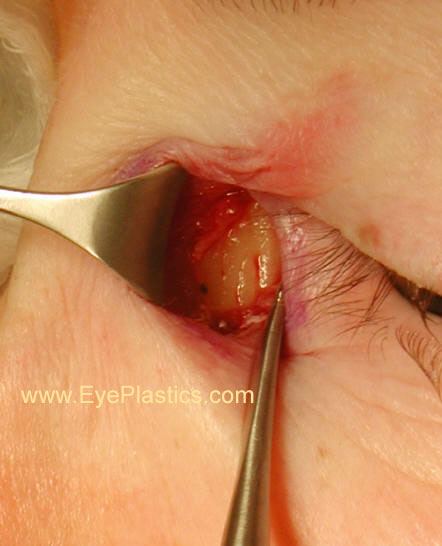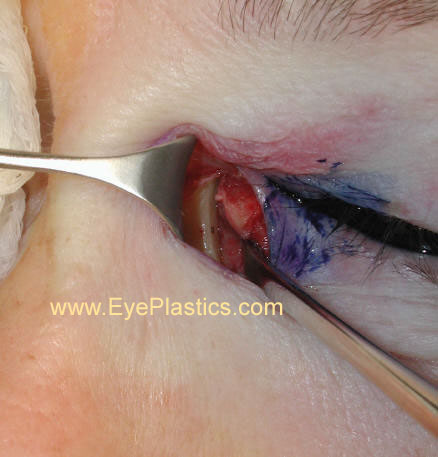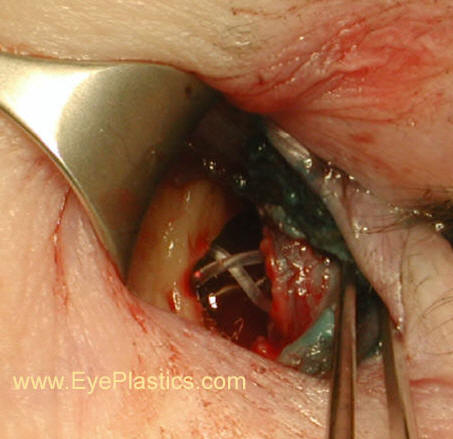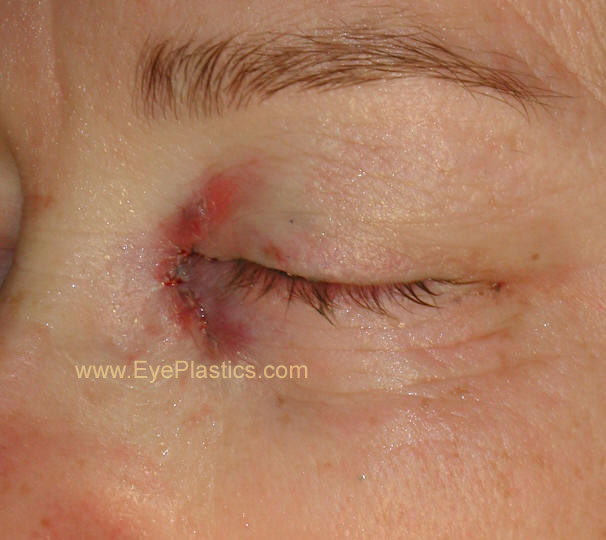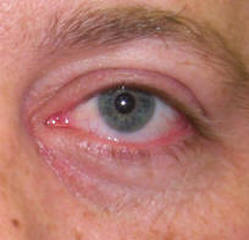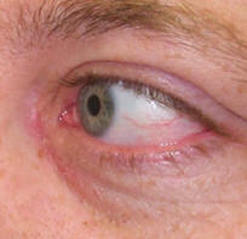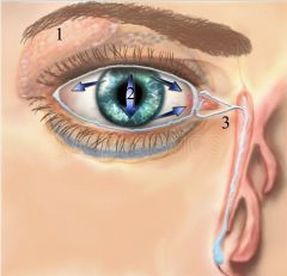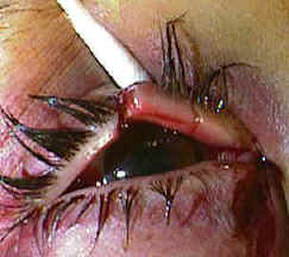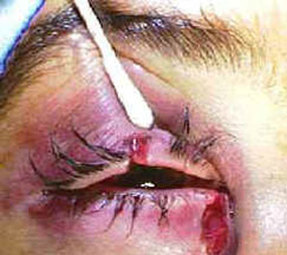Overview, Signs and Symptoms of an Obstruction
The lacrimal gland produces tears which enter into the "duct" that drain the tears from the eye into the nose. The most common symptoms are If one has a plugged up "tear duct," not only will tears spill over the eyelids and run down the face, but the stagnant tears within the system can become infected.
(1) excess tearing (tears may possibly run down the face) and
(2) mucous discharge
This may possibly lead to recurrent red eyes and infections. The excessive tearing can also produce secondary skin changes on the lower eyelids.
(1) excess tearing (tears may possibly run down the face) and
(2) mucous discharge
This may possibly lead to recurrent red eyes and infections. The excessive tearing can also produce secondary skin changes on the lower eyelids.
"Well, the last time I had a picture taken I could hardly see my eyes because of the weight of heavy eyelid. Then I paid attention to how I was actually using my eyes and I really noticed when I was looking at anything especially the computer I was straining my forehead to see better. Since I have had it done I no longer have to lift the forehead and tilt my head to see. It is amazing! I love..." D. Rock 63 Yrs Old with Fat Droopy Eyes - Salt Lake City, UT
Congenital Nasolacrimal Duct Obstruction
The nasolacrimal duct is a duct that connects the lacrimal glands in the eye to the nasal cavity. In this article, we shall briefly review the epidemiology, clinical presentation and the common causes of this condition.
Epidemiology
Epidemiology
- Clinical research has shown that nasolacrimal duct obstruction occurs in 2 to 4 out of 100 newborn babies. However, this number dramatically increases in children who have Down syndrome with statistics suggesting about 22% to 36% developing this condition.
- There are a number of different reasons why nasolacrimal duct obstruction occurs. The epidemiological statistics have shown that of all the cases, 35% of them actually due to obstruction, 15% occur due to the improper formation of the opening of the lacrimal duct (punctual agenesis), 10% have some form of abnormal connection i.e. congenital fistula and 5% have defects in the structure of the head and face.
- As such, congenital nasolacrimal duct obstruction does not differentiate between race and sex. It is typically seen in newborns.
- Congenital nasolacrimal duct obstruction can result in numerous clinical presentations. These conditions bring with them a varying degree of morbidity and mortality.
- The initially condition that may possibly occur is amniotocoele. Here, there is distension of the tear producing gland i.e. the lacrimal gland. Amniotic fluid enters the lacrimal sac and gets trapped within it. This can result in swelling of the lacrimal sac. Treating this can be done through inserting a small probe through the nasolacrimal duct.
- Dacrocystitis is another condition that may possibly develop where there is inflammation and distension of the lacrimal sac. It occurs in the neonatal period which is just after the baby has been born. In these patients as well, probing the lacrimal sac through the nasolacrimal duct is the treatment.
- Finally, in newborns who have narrowing of the nasolacrimal duct, accumulation of pus or pus within the lacrimal sac may possibly take place. This can manifest as constant watering of the eye or expulsion of pus from the eye. The treatment usually involves antibiotics, compression and massage of the lacrimal sac. If left untreated, newborns may possibly have matted eyes every morning and excessive tearing of the eyes.
- simple obstruction
- congenital fistula (as seen below)
- acute dacryocystitis
- congenital dacryocele or mucocele
Congenital Nasolacrimal Duct Obstruction
Clinical presentation
It is commonly accompanied by other eye abnormalities.
Treatment
- History forms an important part of making a diagnosis. There may possibly be a family history of nasolacrimal duct problems and other abnormalities such as glaucoma. A detailed examination of the eye is useful in determining whether the patient has congenital nasolacrimal duct disease.
- A special test known as the dye disappearance test is useful in determining whether there is any obstruction. In addition, tests to ascertain whether the patient has glaucoma need to be conducted.
- Nasolacrimal duct obstruction is not very common but does have some recognised causes. The top three causes include –
- genetic causes i.e. having a family history of nasolacrimal duct obstruction
- premature birth
- drug use by the mother during pregnancy
It is commonly accompanied by other eye abnormalities.
Treatment
- 9 out of 10 cases resolve within the initially year of life. If required, massage therapy over the lacrimal gland may possibly be helpful.
- In patients in whom this does not work, using a probe can cure up to 95% of cases. Other procedures include the insertion of a tube into the nasolacrimal gland or the insertion of a balloon catheter.
- Special surgical procedures include a dacrocystorhinostomy - a procedure that helps restore normal tear flow.
ACQUIRED Nasolacrimal Duct Obstruction
Epiphora is the overflow of tears which is caused by an imbalance in tear production and tear drainage. Other than conditions that cause an abnormal increase in tear production, an abnormality in tear drainage is the most likely cause ofepiphora. It may possibly be either functional due to a displaced punctum, eyelid laxity, weak orbicularis, or facial nerve palsy or an anatomical obstruction may possibly block the drainage of tears. Anatomical obstruction of the nasolacrimal duct may possibly be congenital which occurs during the neonatal period or acquired which manifests during adulthood.
Classification of Acquired Nasolacrimal Drainage Obstruction (NLDO)
Acquired nasolacrimal drainage obstruction may possibly be primary or secondary.
- Primary acquired nasolacrimal drainage obstruction (PANDO) is caused by inflammation or fibrosis without any precipitating cause. The name was given by Linberg and McCormick in 1986.
- Secondary acquired lacrimal drainage obstruction (SALDO) is further classified further based on aetiology as infectious, inflammatory, neoplastic, traumatic and mechanical. This classification was proposed by Bartley.
Although quite common, the frequency of nasolacrimal drainage obstruction is unknown. It has no racial predilection.
PANDO is more commonly seen in middle-aged and elderly females. This is due to the significantly smaller dimensions in the lower nasolacrimal fossa and middle nasolacrimal duct among women. Middle-aged women exhibit alterations in the dimensions of the bony nasolacrimal canal that coincides with osteoporotic changes elsewhere in the body, which supports the higher incidence of PANDO in women. Some suggest that sudden hormonal changes incite generalized de-epithelialization predisposing a narrow duct to be blocked by sloughed off debris.
SALDO is aetiologically classified as infectious, inflammatory, neoplastic, traumatic, and mechanical.
Infectious lacrimal drainage obstruction: Bacteria, viruses, fungi, and parasites that have all been implicated are as follows:
- Bacterial Causes – Most common causes are Actinomyces, Propionibacterium, Fusobacterium, Bacteroides, Mycobacterium, and Chlamydia.
- Viral Causes – Most commonly Herpes virus. Due to canalicular obstruction and damage.
- Fungal Causes - Aspergillus, Candida, Pityrosporum, and Trichophyton. Usually cause obstruction due to dacryolith/stone or cast formation.
- Parasitic Causes – Rare but can be caused by Ascaris lumbricoides entering through the valve of Hasner.
Inflammatory lacrimal drainage obstruction: May be endogenous or exogenous in origin.
- Endogenous Causes – Most commonly due to Wegener granulomatosis and sarcoidosis. Other causes include cicatricial pemphigoid, sinus histiocytosis, Kawasaki disease, and scleroderma.
- Exogenous Causes – Eye drops, radiation, systemic chemotherapy, and bone marrow transplantation all cause punctal and canalicular scarring, stenosis and occlusion in varying degrees.
Neoplastic lacrimal drainage obstruction: Neoplasms cause obstruction by primary growth, secondary spread, or metastatic spread.
Traumatic lacrimal drainage obstruction: May be iatrogenic or non-iatrogenic.
- atrogenic Causes - Trauma and subsequent scarring due to overenthusiastic lacrimal probing, orbital decompression surgery, paranasal, nasal, and craniofacial surgery all cause obstruction.
- Non-iatrogenic Causes - Either blunt or sharp injury to the canaliculus, lacrimal sac, and nasolacrimal duct results in post-traumatic dacryostenosis.
Mechanical lacrimal drainage obstruction
- Intraluminal foreign bodies – Dacryoliths or casts due to infection or long-term use of topical medications.
- External compression – Due to rhinoliths, nasal foreign bodies, or mucoceles. Dentigerous cyst in the maxillary sinus is also thought of as a culprit.
Symptoms/Presentation
- Patients with NLDO most commonly present with epiphora, mucoid or purulent discharge with a painful, swollen medical canthus. They commonly have features of recurrent dacryocystitis, recurrent conjunctivitis, or ocular pemphigus. Some cases present with bloody tears and even epistaxis as in nasal, sinus or lacrimal sac tumours.
- A thorough past ocular and medical history is in order to evaluate the cause of the disease. Always ask for previous eye surgery, lid surgery, use of antiglaucoma medications, or any other topical medications. Past medical history should all causes cited in the previous section.
On examination, the following findings may possibly be present.
- Gross observation shows overflowing tears, fluctuant tender mass over medial canthus, mucoid or purulent eye discharge. Regurgitation test results in mucoid reflux with lacrimal massage indicating lower system obstruction.
- Slit lamp examination shows enhancement of tear meniscus height by fluorescein greater than 2 mm, punctal stenosis, canaliculitis, concretions expressed from the punctum
Investigations
- Laboratory studies include sending lacrimal discharge for Gram/Giemsa stain, culture and sensitivity, KOH and anticytoplasmic antibodies.
- Imaging studies may possibly include dacryocystography, dacryoscintigraphy, CT scan, CT dacryocystography (CTDCG), nasal endoscopy, or Gadolinium-enhanced magnetic resonance dacryocystography.
- Other tests include Schirmer test, Fluorescein dye disappearance test, lacrimal irrigation, probing of the canaliculi, Jones dye tests, microreflux test, Hornblass saccharine test
- Diagnostic canalicular irrigation determines the level of canalicular obstruction staging it as partial obstruction, total common canalicular obstruction, total functional occlusion and complete nasolacrimal obstruction.
Treatment
Medical Care
- Topical antibiotics in early infections
- Systemic antibiotics in chronic or severe infections
Surgical Care
- External dacryocystorhinostomy
- Endoscopic mechanical/nonlaser dacryocystorhinostomy
- Endoscopic laser dacryocystorhinostomy
- Endoscopic laser-assisted dacryocystorhinostomy
- Conjunctivodacryocystorhinostomy (CDCR)
- Balloon catheter dilatation
- Inferior meatus surgery
Right lacrmal sac tumour causing nasolacrimal duct obstruction
Lacrimal System Infections
|
Dacryoadenitis
|
Canaliculitis
|
Pathophysiology of canaliculitis
- As has been mentioned above, canaliculitis occurs due to infection of the canaliculi. This infection is often brought on by bacteria though there might be alternative aetiology such as fungi and viruses as well. The most common cause of canaliculitis is Actinomyces Israelii. However, the other causes can include aspergillus, Canada albicans and even herpes simplex and herpes zoster virus.
- Infection by these organisms results in the formation of tiny stones that are rich in sulphur. These stones form little pockets that unfortunately are not affected by the antimicrobial properties of tears.
History and examination
Patients often complain of a long-standing history of one eye being red and inflamed. The inner aspect of the eye constantly displays a thick discharge which can be clear or rather discoloured.
On examination, the lacrimal punctum is swollen and inflamed. The swelling is due to accumulation of fluid and is called oedema. The area is tender to touch. When gently compressed, the cloudy, purulent discharge is expressed through the punctum.
On examination, the lacrimal punctum is swollen and inflamed. The swelling is due to accumulation of fluid and is called oedema. The area is tender to touch. When gently compressed, the cloudy, purulent discharge is expressed through the punctum.
Diagnosis
Diagnosis is through clinical history and examination in most cases. If a probe is passed through the lacrimal punctum, a grating sensation is experienced due to the presence of sulphur stones (concretions) within it.
Laboratory investigations are conducted on the discharge. Tests are conducted to ascertain the type of infection that is affecting the canaliculus. Staining might be performed with a different stains and microscopic assessment might reveal the presence of organisms such as Actinomyces or aspergillus.
Laboratory investigations are conducted on the discharge. Tests are conducted to ascertain the type of infection that is affecting the canaliculus. Staining might be performed with a different stains and microscopic assessment might reveal the presence of organisms such as Actinomyces or aspergillus.
Treatment
The treatment of canaliculitis is fairly straightforward and involves the application of warm compressions, massage of the local area and antibiotic creams and ointments applied locally. These treatments might or might not help the patient. In the event of this being the case, patients might require to undergo a surgical procedure to help clear the infection. This is usually offered when irrigation with a sterile solution and broad-spectrum antibiotics is ineffective. Procedures can include deployment of the canaliculus through a procedure called canaliculotomy.
The procedure is fairly straightforward and is performed by making a tiny incision on the conjunctival aspect of the canaliculus. The sulphur concretions are then removed and antibiotics are used to clear any residual infection.
The procedure is fairly straightforward and is performed by making a tiny incision on the conjunctival aspect of the canaliculus. The sulphur concretions are then removed and antibiotics are used to clear any residual infection.
Conclusion
- Canaliculitis is a rare condition that affects individuals over the age of 50 years. It is characterised by bacterial or fungal infections within the canaliculi and the formation of concretions that are rich in sulphur. Treatments can include topical antibiotics and drainage, though in some cases surgical treatment might be required.
- Symptoms include pain, swelling, tenderness of the INNER canthus of the eye
- Etiology is usually actinomycetes
Dacryocystitis
- Symptoms: acute onset, tearing (from nasolacrimal duct obstruction), redness, purulent discharge, tender swollen lacrimal sac
- An infection within the "tear duct" causes a painful swelling in the inner corner of the eyelids.
- If the tearing causes severe symptoms, surgery can be performed to create a new tear duct. This operation is called "dacryocystorhinostomy." (see below). Small silicone tubes my be placed in the tear system to keep the new tear duct open while healing occurs. Surgical elimination of the obstruction by creating a new tear duct is necessary to eliminate the tearing and infection that can result from such a blockage
Acute Dacryocystitis
Numerous etiologies, all cause nasolacrimal duct obstruction with obstruction of drainage from lacrimal sac to nos
- chronic tear stasis causes 2o infxn
- edema, erythema below medial canthal tendon w/lac sac distention
- +/- pain
- rule out ethmoidal sinusitis, don't probe
Treatment
- warm compresses
- oral/IV abx (Keflex, Augmentin), topical only limited value
- Incision Drainage localized abscess
Complications
- mucocele, chronic conjunctivitis, orbital cellulitis
- most need DCR after acute infection subsides
Chronic Dacryocystitis
- distended lac sac with minimal inflammation suppurative discharge from punctum c/w nasolacrimal duct obstruction
- probe/irrigate upper system only
- dacryoliths from Actinomyces, Candida, topical meds, can cause lacrimal colic if impacted in NLD
- Treatment usually needs DCR for resolution
- Lacrimal System Infectons
Traditional Surgical Treatments
Since its introduction in the early years of this century, Incisional dacryocystorhinostomy (DCR) has been the "traditional" procedure most often relied upon for relief of epiphora (chronic tearing) and nasolacrimal duct obstruction in adults. However, the high success rate (> 90%) for incisional DCR is balanced by a number of potential drawbacks:
- Recovery time is significant
- An incisional scar may possibly develop due to invasive procedure
- Potential for excess bleeding
- May not be necessary for partial obstructions
Dacryocystorhinostomy (DCR)
MAC with Local
|
Create Ostium
|
|
STEP 1:
The LacriCATH ® balloon catheter (shown in the picture) is inserted through an opening in the corner of the eye and down into the tear duct .® balloon catheter (shown in the picture) is inserted through an opening in the corner of the eye and down into the tear duct .balloon catheter (shown in the picture) is inserted through an opening in the corner of the eye and down into the tear duct .
The LacriCATH ® balloon catheter (shown in the picture) is inserted through an opening in the corner of the eye and down into the tear duct .® balloon catheter (shown in the picture) is inserted through an opening in the corner of the eye and down into the tear duct .balloon catheter (shown in the picture) is inserted through an opening in the corner of the eye and down into the tear duct .
STEP 2:
The balloon catheter is inflated with sterile water to dilate the tear duct for a period of 90 seconds. It is then deflated, and reinflated for 60 seconds.
STEP 3:
The balloon catheter is then repositioned slightly higher in the duct and inflated twice as in step 2.
The balloon catheter is inflated with sterile water to dilate the tear duct for a period of 90 seconds. It is then deflated, and reinflated for 60 seconds.
STEP 3:
The balloon catheter is then repositioned slightly higher in the duct and inflated twice as in step 2.
The balloon catheter is then deflated and removed.
CDCR / JONES tube / PG tube
If the "tear duct" obstruction is beyond repair, It may possibly be necessary to surgically implant an artificial "tear duct" behind the inner corner of the eyelids to drain the tears into the nose. The artificial "tear duct" is made of Pyrex glass and is called a "Jones tube." or Putterman-Gladstone (PG) tube.
These may possibly be purchased at Gunther Weiss Glass Science, located in Portland Oregon. 503-644-3507
Dacryocystorhinostomy surgery provides relief to millions of people every year who suffer from tear duct problems ranging from collapsed tear ducts and excessive tearing caused by accident or injury, birth defects or environmental strain. Left untreated, patients may possibly experience swelling, infections, increased swelling, tearing ("wet eye") and severe pain.
In 1961, Lester T. Jones and Gunther Weiss paired up to develop a solution for tear duct problems. They developed highly specialized glass tubes (called "Lester T. Jones Tear Duct Tubes") designed for insertion into the nasolacrimal duct. The body develops scar tissue around the tube, which holds it in place, forming a new permanent tear duct.
Gunther Weiss Scientific Glass Blowing Company offers Lester T. Jones Tear Duct Tubes in a variety of lengths and diameters to address most patient needs. In addition, tubes can be custom-fabricated to accommodate unique angles and sizes.
Dacryocystorhinostomy surgery provides relief to millions of people every year who suffer from tear duct problems ranging from collapsed tear ducts and excessive tearing caused by accident or injury, birth defects or environmental strain. Left untreated, patients may possibly experience swelling, infections, increased swelling, tearing ("wet eye") and severe pain.
In 1961, Lester T. Jones and Gunther Weiss paired up to develop a solution for tear duct problems. They developed highly specialized glass tubes (called "Lester T. Jones Tear Duct Tubes") designed for insertion into the nasolacrimal duct. The body develops scar tissue around the tube, which holds it in place, forming a new permanent tear duct.
Gunther Weiss Scientific Glass Blowing Company offers Lester T. Jones Tear Duct Tubes in a variety of lengths and diameters to address most patient needs. In addition, tubes can be custom-fabricated to accommodate unique angles and sizes.
Lacrimal Trauma
Overview
- Canalicular lacerations are breaks (interruptions) in the normal tear duct drainage system. If not repaired promptly, tearing will usually result.
- This systems originates with the puncta (there is one in both the upper and the lower eyelid) and is a conduit for tears to travel from the eyelid through the nasolacrimal sac into the nose.
- Tension, from trauma such as a blow from the fist, can result in an eyelid laceration which involves the canalicular system.
- Repair requires re-approximation of the eyelid as well as re-approximation of the conduit; this is best achieved with a stent such as with silastic and fine sutures such as 6,7, or 8-0 vicryls.
Treatment
There are several different means to repair such an injury. Placement of a stent (silastic tubing) helps maintain proper alignment of the conduit and prevent stricture after the repair.
Bi-canalicular stent
This places places a silicone stent in both the traumatized (lacerated) canalicular system as well as the normal. One disadvantage of this technique is the potential damage to the "good" canalicular system.
Mono-canalicular stent
This places places a silicone stent ONLY in the traumatized (lacerated) canalicular system and thus avoids potential damage to the "good" canalicular system. A mini-Monoka or Monoka monocanalicular stent is typically used
These three photos show a canalicular laceration and its repair with a Monoka monocanalicular stent.
There are several different means to repair such an injury. Placement of a stent (silastic tubing) helps maintain proper alignment of the conduit and prevent stricture after the repair.
Bi-canalicular stent
This places places a silicone stent in both the traumatized (lacerated) canalicular system as well as the normal. One disadvantage of this technique is the potential damage to the "good" canalicular system.
Mono-canalicular stent
This places places a silicone stent ONLY in the traumatized (lacerated) canalicular system and thus avoids potential damage to the "good" canalicular system. A mini-Monoka or Monoka monocanalicular stent is typically used
These three photos show a canalicular laceration and its repair with a Monoka monocanalicular stent.
Schedule Your Consult Today |
"I had a excellent eye lift done by Dr. Patel. He knows what he is doing and is very pleasant. Dr.Patel was easy to get an appointment and he works with you. The office staff was very pleasant and made you feel calm." D. Gull Highly recommended for eye lift surgery - Salt Lake City, UT
|
Visit Patel Plastic Surgery on YouTube for more free tips!
Stay Connected With Us On Social Media
|
Find UsLocations:
Dr. BCK Patel MD, FRCS 1025E 3300S Salt Lake City, Utah 84106, USA (801) 413-3599 (phone/text) E: [email protected] bckpatel.info --------------------------------------- Dr. BCK Patel MD, FRCS 585 E Riverside Dr Suite 201 Saint George, UT 84790 (435) 215-0014 E: [email protected] Quick-Link |
Let Us answer your questions |

